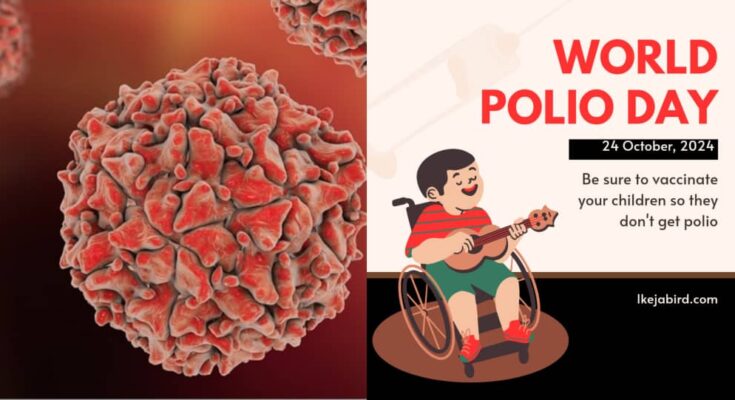Polio, short for poliomyelitis, is a disease that has haunted humanity for centuries, causing severe disabilities and even death.
World Polio Day, observed on October 24th, serves as a reminder of the progress made in the fight against polio and the importance of continued efforts to eradicate this devastating disease.
In this comprehensive article, we will look into polio’s origin, causes, and prevention, using simple language to make this critical topic accessible to all.
History of Polio
How it all started
Polio is not a recent discovery; it has been affecting humans for thousands of years. The first recorded polio outbreak dates back to ancient Egypt.
Hieroglyphics on the tombs of Egyptian pharaohs show depictions of individuals with withered limbs, a possible sign of polio. Similarly, ancient Indian texts describe symptoms resembling polio.
Polio in the Modern Era
Fast-forward to the 20th century, and polio became a global health crisis. Outbreaks in the United States and Europe led to widespread fear and social isolation.
In the early 20th century, polio was often referred to as “infantile paralysis” because it predominantly affected young children.
Polio Vaccine Breakthrough
The most significant breakthrough in the fight against polio came in the 1950s with the development of vaccines.
Dr. Jonas Salk’s inactivated polio vaccine (IPV) and, later, Dr. Albert Sabin’s oral polio vaccine (OPV), brought hope to millions. These vaccines marked a turning point in the battle against polio.
READ ALSO: This is for Enioluwa: Top 10 Nigerian delicacies every food lover must try
Understanding Polio
What is Polio?
Polio is a highly contagious viral disease caused by the poliovirus. It primarily targets the nervous system, leading to paralysis, muscle weakness, and, in severe cases, death. There are three types of poliovirus, known as P1, P2, and P3, each capable of causing polio.
How Does Polio Spread?
Polio primarily spreads through the faecal-oral route, which is transmitted through contact with infected faeces or contaminated water. The virus can also spread through respiratory droplets when an infected person coughs or sneezes.
Polio: The Different Types
There are two forms of polio: non-paralytic and paralytic. Non-paralytic polio causes flu-like symptoms, such as fever, sore throat, and headache, but does not lead to paralysis. Paralytic polio, conversely, causes muscle weakness and can result in permanent paralysis.
Post-Polio Syndrome
Even after recovering from the initial infection, some polio survivors may experience a condition known as post-polio syndrome (PPS). PPS can occur many years after the initial illness and involves re-emerging muscle weakness and pain.
READ ALSO: Everything to know about malaria new vaccine approved by WHO
Polio Symptoms and Diagnosis
Recognizing Polio Symptoms
Polio symptoms can vary, but common signs of paralytic polio include muscle weakness, stiffness, and loss of reflexes. The muscles of the limbs are most commonly affected.
Diagnosing Polio
Doctors can diagnose polio through a combination of physical examinations and laboratory tests. The detection of the poliovirus in stool samples or cerebrospinal fluid can confirm the diagnosis.
Polio Vaccine
Inactivated Polio Vaccine (IPV)
The inactivated polio vaccine (IPV), developed by Dr. Jonas Salk, is an injectable vaccine that contains killed poliovirus. It is highly effective in preventing polio and has been a cornerstone of polio vaccination efforts in many parts of the world.
Oral Polio Vaccine (OPV)
The oral polio vaccine (OPV), developed by Dr. Albert Sabin, is a live attenuated vaccine. It is administered orally and is particularly useful in regions with limited access to healthcare facilities.
Vaccination Schedule
Children typically receive multiple doses of the polio vaccine, starting at 2 months of age. The number of doses and the type of vaccine can vary depending on the country’s vaccination program.
The Importance of Herd Immunity
Herd immunity is the concept that when a significant portion of a population is immune to a disease, it indirectly protects those who are not immune, reducing the spread of the disease. Achieving herd immunity is crucial for polio eradication.
Polio Prevention and Control
Hygiene and Sanitation
Improving hygiene and sanitation is crucial in preventing the spread of polio. Access to clean water and proper sanitation facilities can help reduce the transmission of the virus.
Surveillance and Monitoring
Monitoring for polio cases and the presence of the virus in communities is essential for early detection and containment of outbreaks. Surveillance efforts are a cornerstone of polio eradication.
Mass Vaccination Campaigns
Mass vaccination campaigns are conducted to reach every child in a community, even in remote or conflict-affected areas. These campaigns aim to boost immunity and close immunity gaps.
Global Collaboration
Polio eradication is a collaborative effort, with many organizations and governments working to fight this virus
The World Health Organization (WHO), in partnership with organizations like UNICEF and the Bill & Melinda Gates Foundation, launched the Global Polio Eradication Initiative in 1988. The goal: to eradicate polio from the face of the Earth








